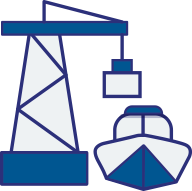Ports

The Port Demonstrator will be implemented in Funchal (Madeira Island, Portugal) and has two main objectives: to study the potential of DC in Ports by leveraging a Digital Twin of the Funchal Port and to analyze user perspectives.
The methodologies developed in the Portuguese Demo, in particular to what concerns the user acceptance and adoption of DC technologies, will be adopted and replicated across the four demos.
The port digital twin will be developed in the Funchal Port, the largest in Madeira Island, which is divided into four main areas: the terminals for cruise ships, one ferry terminal (to connect Madeira and Porto Santo), a terminal for warships, and a terminal for yachts and small boats.
One of the main challenges of the Port of Madeira is its complete electrification allowing the interconnection with ships, contributing to International Maritime Organization’s (IMO) goals and a reduction of 40% in carbon emissions by 2030. On a peak day, the port can have up to 4 tourism cruises docked.
The demonstration will be developed into two phases:
- Design of the DC distribution grid to be developed in the Port.
- Development of a port digital twin. This demonstrator will combine the measurements of the energy consumption of actual equipment already existing in the port with digital twins of equipment that are not yet installed.
Four Use Cases (UCs) will be tested on this demonstrator:
- DC Port management: large cruise ship can reach a peak consumption of 10 MW and in Madeira which can create a major impact in the global system of Madeira. One of the main challenges that Ports face is to mitigate the impact of connecting new ships without disrupting the entire network. In this context, the main goal of this UC is to demonstrate the usage of BESS (Battery Energy Storage System) to promote battery-buffered charging strategies to mitigate the impact of connecting new ships to the Port.
- DC port / Grid coordination: considering the capacity of the photovoltaic (PV) and energy storage systems that could be installed in the Port, several services can be provided to the grid, mainly when no ships are docked. In this UC, the Port will contribute to the grid stabilization with different services, including frequency and voltage support and energy arbitrage to avoid wind production limitation on the island.
- DC Microgrid: a characteristic of Ports is their operation as a microgrid (isolated from the grid), which can improve reliability and resilience to grid disturbances. This UC will demonstrate the scenario where the Port will momentarily operate in islanded mode. The storage and other DC assets and devices must be coordinated to ensure the Port’s operation until grid reconnection is possible.
- Port as a DC Energy Hub: showcase the Port as an energy hub. To this end, hydrogen systems (storage and on-site generation) will be considered for electricity generation alongside PV generation and ESS.
The demonstrator will be developed in several steps, from the detailed specification, design, and implementation to the validation of the most important KPIs.
Demo Leader: ITI
Participants: APRAM, INESC ID, EDP NEW, FINCANTIERI, CIRCE AND EDF.






